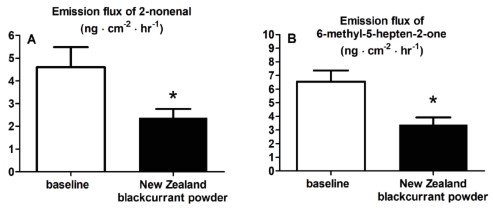ANTHOCYANIN-RICH
NEW ZEALAND BLACKCURRANT:
IMPLICATIONS FOR HEALTH*
POLYPHENOLS & SPORT NUTRITION

Studies on the post-exercise effects by fruits (e.g. blueberry/banana and metabolic recovery after 75 km cycling (1), cherry and recovery following marathon running (2), chokeberry and rowing-induced inflammation and iron metabolism (3), blueberry and natural killer cells, oxidative stress and inflammation after 2.5 h of running (4), bilberry and muscle damage and inflammation after a half-marathon (5), and blackcurrant and rowing-induced oxidative stress and inflammation (6)) provided the diversity of responses with application for athletes. Some of the observations from these studies can be linked to the fruit-induced anti-oxidant and anti-inflammatory effects. Anti-oxidant and anti-inflammatory effect by regular fruit intake can also provide health benefits due to the major class of polyphenols, the flavonoids and major sub-class the anthocyanins (7) with an importance for anthocyanin type and content (8). Dark-colored berries are rich in anthocyanins. In berry-producing plants, anthocyanins are secondary metabolites with a suggested role in stress protection (9). The berry blackcurrant (Ribes Nigrum Linnaeus) contains primarily the anthocyanins delphinidin-3-O-rutinoside (~51.5%), delphinidin-3-O-glucoside (~14.6%), cyanidin-3-O-rutinoside (~27.1%) and cyanidin-3-O-glucoside (~4.2%) (www.phenol-explorer (10)). This mini-review will address potential effects by short-term intake of powder and extract made from New Zealand blackcurrant on some physiological and metabolic responses at rest and during exercise in physical active individuals with application for human health.
INTRODUCTION
Exercise-induced fat oxidation by skeletal muscle is a process starting with the release of free fatty acids from adipocytes, the subsequent blood transport of the free fatty acids to the muscle, uptake in the muscle and final degradation of the fatty acids in the mitochondria to allow the resynthesis of ATP. The process involves adipocyte-located enzymes, the blood transport protein albumin, muscle cell membrane transporters, muscle cell cytosol-located proteins and mitochondria-located enzymes. Free fatty acids are a substantial energy source during moderate-intensity exercise (11). In a follow-up from studies that showed enhanced cycling-induced fat oxidation by 7-day intake of New Zealand blackcurrant extract in endurance trained male (12,13) and female cyclists (14), the effects of intake duration and intermittent intake on walking-induced whole-body fat oxidation were examined in recreationally active males. The exercise modality was treadmill walking at an intensity of 5 metabolic equivalent (i.e. 5 times the oxygen uptake at rest with moderate-intensity considered to be between 3 and 6 metabolic equivalents). For the general population, moderate-intensity walking is commonly recommended for weight management and health benefits (15). During moderate-intensity walking, there was no effect by intake of New Zealand blackcurrant extract on the physiological responses, i.e. heart rate, minute ventilation, oxygen uptake and carbon dioxide production (16). However, compared to baseline, both the 7-day and 14-day intake of New Zealand blackcurrant extract enhanced walking-induced whole body fat oxidation in recreationally active Caucasian males by 11% and 17%, but without an intake duration effect (Figure 1).
In East-Asian males, enhanced walking-induced fat oxidation with 7-day intake of New Zealand blackcurrant extract was not observed (17).
It also needs to be noted that enhanced whole-body fat oxidation by intake of New Zealand blackcurrant extract in Caucasian males required a daily dosing strategy. When New Zealand blackcurrant extract was taken every other day for two weeks, no effects on walking-induced whole body fat oxidation were observed (18).
This suggest that daily intake of New Zealand blackcurrant extract may result in a build-up of anthocyanin-derived metabolites that alter the process of exercise-induced fat oxidation. Interestingly, in recreationally active females, we have also observed enhanced whole body fat oxidation during moderate-intensity walking with drinking of Matcha green tea by 18% ((4 cups with 1 gram/cup over 24 hours (19)) and capsulated Matcha by 35% ((3x1 gram/day for 3 weeks (20)). Studies should examine in recreationally active females the effects of intake of New Zealand blackcurrant extract on walking-induced fat oxidation. Nevertheless, the applications for enhanced exercise-induced fat oxidation by New Zealand blackcurrant extract are not clear. For individuals with weight management issues, intake of fat burners during exercise will not be as potent compared to reducing calory intake and increasing physical activity levels. It is also not known whether New Zealand blackcurrant extract is able to enhance fat oxidation at rest. Future work should address whether effects on whole-body fat oxidation by daily long-term intake of the anthocyanin-rich New Zealand blackcurrant will provide health benefits.
NEW ZEALAND BLACKCURRANT EXTRACT AND WALKING-INDUCED FAT OXIDATION

Figure 1. % change in fat oxidation by intake of New Zealand blackcurrant (NZBC) extract during moderate-intensity walking in recreationally active males. Intake was 210 mg of anthocyanins every day for 7- and 14 days.
Restricted blood flow may contribute to the development of cardiovascular diseases. Cardiovascular diseases are a major cause of death worldwide. Supplementation that affects cardiovascular function may have beneficial long-term health effects. In 2005, meaningful effects of a blackcurrant concentrate (17 mg anthocyanins·(kg body weight)-1) on peripheral circulation were observed (21). Forearm blood flow was measured with near-infrared spectroscopy. The acute intake of blackcurrant concentrate increased blood flow within one hour and remained elevated for the three subsequent hours by about 20%. The authors speculated that the enhanced blood flow is due to anthocyanin metabolites with antioxidant activity (21). In Barnes et al (22), forearm blood flow was measured with venous occlusion plethysmography and forearm circumference measurements after intake of New Zealand blackcurrant extract. Blackcurrant extract abolished the decrease in forearm blood flow during prolonged sitting between 90 and 120 min and this observation was associated with the absence of a change in vascular resistance (22). The studies by Matsumoto et al (21) and Barnes et al (22) suggest an acute effect by intake of blackcurrant on hemodynamic responses, at least for forearm blood flow. In a study on the effects of intake duration (7- and 14-days) of New Zealand blackcurrant extract in recreationally active males, a beat-to-beat finger pressure recording was used for non-invasive continuous measurement of hemodynamic parameters during supine rest (23). During supine rest, there were no intake duration effects on cardiovascular parameters that were altered by intake of New Zealand blackcurrant extract, i.e. cardiac output, diastolic blood pressure, mean arterial pressure, and total peripheral resistance, with no changes observed for heart rate and systolic blood pressure (23). In older adults in Japan, 7-days intake of New Zealand blackcurrant extract reduced central blood pressure and central arterial stiffness (24). Systolic and diastolic blood pressure was also reduced in Caucasian older adults by 7-day intake of New Zealand blackcurrant extract (25). This suggest that age-dependent effects by New Zealand blackcurrant extract on cardiovascular function during rest cannot be excluded. Future work is encouraged to examine the mechanisms and potential lasting effect of daily blackcurrant intake on blood flow and whether there is a systemic effect that promotes health.
NEW ZEALAND BLACKCURRANT EXTRACT AND CARDIOVASCULAR FUNCTION AT REST
The role of dietary anthocyanins in reducing insulin resistance is well recognized (26). However, it is still not clear whether intake of specific anthocyanins is required to optimize the increase in insulin sensitivity. In a cross-sectional study in females (n=1997, age: 18-76 years), the intake of the anthocyanin delphinidin, which is one of the main anthocyanins in blackcurrant, was associated with lower fasting insulin (27). The intake of anthocyanin-rich blackcurrant drinks immediately before a meal that was high in carbohydrates reduced the postprandial glucose and insulin levels (28). However, studies on the acute intake effects of anthocyanins will not provide information on potential adaptations by chronic daily intake. We examined the effect of 7-days intake of New Zealand blackcurrant powder (6g·day-1, 138.6 anthocyanins·day-1) on postprandial glucose and insulin in non-diabetic individuals (9 males, age: 27±12 years, body mass index: 24.9±2.6 kg·m-2; 8 females, age: 23±2 years, body mass index: 25.7±4.5 kg·m-2) (29).
The 7-day intake of New Zealand blackcurrant powder seem to result in a trend for lower fasting insulin by 14% but had no effect of fasting glucose (29).
However, following intake of 75 gram of carbohydrate as part of the oral glucose tolerance test, there was a trend for lower glucose by 5.7% and lower insulin by 31.1% (i.e. area under the curve) over a 2-hr period. These observations seem to suggest a change in insulin sensitivity with 7-day intake of New Zealand blackcurrant powder. In overweight individuals (n=13, 10 males), following ingestion of 75 g maltodextrin, 7-day intake of New Zealand blackcurrant extract provided lower glucose by 8% and lower insulin by 14% (i.e. area under the curve) over a 2-hr period, with an increase of 22% of the Matsuda insulin sensitivity (30). However, more importantly is whether postprandial responses with mixed-macronutrients meals can be affected by intake of New Zealand blackcurrant.
In the same study by Nolan et al, the free-living postprandial glucose responses to both breakfast and lunch meals were reduced by 9% and 8% (30). Interestingly, in Nolan et al (30), no effects were observed on insulin sensitivity by a single dose. Repeated intake of New Zealand blackcurrant is required to improve insulin sensitivity and promote health.
NEW ZEALAND BLACKCURRANT POWDER/EXTRACT AND INSULIN SENSITIVITY
Human body odor over the age of 40 years can result from skin bacterial and sebaceous gland lipid peroxidation activity. The skin emission of volatile organic compounds that can be the product of lipid peroxidation, e.g. the unsaturated aldehyde 2-nonenal, is linked with body odor in older individuals (31, 32). The analysis of skin emissions of volatile organic compounds VOCs is an emerging research discipline to allow detection of non-invasive biomarkers of internal metabolic processes linked with health and disease (33). With regard to the skin, more than 500 volatile organic compounds have been identified (34). Much work is needed to address the effect of specific dietary components on the production and emission of skin volatile organic compounds. We examined the effect of anthocyanin-rich New Zealand blackcurrant powder on emission of volatile organic compounds from the skin in middle-aged and older adults (35). Due to the fact that aging is associated with a detrimental change of the internal anti-oxidant defence system, it would be of interest to examine the effect of a berry with known anti-oxidant effects. In the study, fourteen adults (9 males, age: 55±5 yr) consumed New Zealand blackcurrant powder for 7 days (6 g·day-1 with 138.6 mg anthocyanins·day-1). Volatile organic compounds were collected with a passive flux sampler with trapping media (36), that was applied in the base of the neck for one hour and gas chromatography-mass spectrometry was used for media analysis. New Zealand blackcurrant powder was able to reduce the unsaturated aldehyde 2-nonenal by 39% (Figure 2A). It was also interesting that the percentage changes in 2-nonenal was not associated with the normal habitual anthocyanin intake of the participants. This would suggest that even in individuals with relatively high anthocyanin intake, the intake of New Zealand blackcurrant powder can still have an effect. A decrease by 48% in skin emission rate was also observed for the ketone 6-methyl-5-hepten-2-one (Figure 2B) with similar to the observations with 2-nonenal, no association for the percental change with habitual dietary anthocyanin intake. These observations suggest that New Zealand blackcurrant powder may reduce body odor in older individuals.
NEW ZEALAND BLACKCURRANT POWDER AND SKIN VOLATILE ORGANIC COMPOUNDS

Figure 2. Emission flux of the skin volatile organic compound 2-nonenal (A) and 6-methyl-5-hepten-2-one (B). N=14. Intake of NZBC was for 7 days. Emission flux was lower with New Zealand blackcurrant powder.
Short-term intake of New Zealand blackcurrant is able to provide diverse and meaningful physiological and metabolic responses. The changes in exercise-induced fat oxidation, cardiovascular function at rest, insulin sensitivity and skin emission of volatile organic compounds will be indicative of strong potential to promote human health.
CONCLUSION
*Article previously published in Agro Food Industry Hi Tech 33(1) 2022.
Bio...
Dr. Mark Willems is currently Professor of Exercise Physiology in the Institute of Sport, Nursing and Allied Health at the University of Chichester (United Kingdom). He has an interest in the application of functional foods in sport, exercise and health with focus on effects of polyphenol intake. Mark is a fellow of the European College of Sport Science.

MARK WILLEMS
Institute of Sport, Nursing and Allied Health, University of Chichester | United Kingdom




